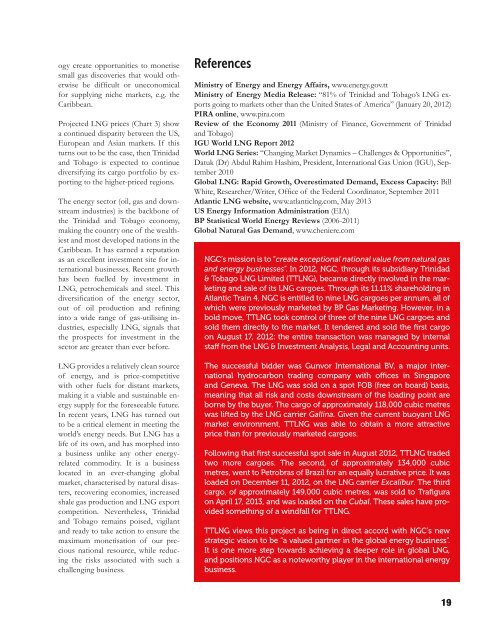GASCO News (Volume 24, November 2013)
Produced for the National Gas Company of Trinidad & Tobago
Produced for the National Gas Company of Trinidad & Tobago
You also want an ePaper? Increase the reach of your titles
YUMPU automatically turns print PDFs into web optimized ePapers that Google loves.
ogy create opportunities to monetise<br />
small gas discoveries that would otherwise<br />
be difficult or uneconomical<br />
for supplying niche markets, e.g. the<br />
Caribbean.<br />
Projected LNG prices (Chart 3) show<br />
a continued disparity between the US,<br />
European and Asian markets. If this<br />
turns out to be the case, then Trinidad<br />
and Tobago is expected to continue<br />
diversifying its cargo portfolio by exporting<br />
to the higher-priced regions.<br />
The energy sector (oil, gas and downstream<br />
industries) is the backbone of<br />
the Trinidad and Tobago economy,<br />
making the country one of the wealthiest<br />
and most developed nations in the<br />
Caribbean. It has earned a reputation<br />
as an excellent investment site for international<br />
businesses. Recent growth<br />
has been fuelled by investment in<br />
LNG, petrochemicals and steel. This<br />
diversification of the energy sector,<br />
out of oil production and refining<br />
into a wide range of gas-utilising industries,<br />
especially LNG, signals that<br />
the prospects for investment in the<br />
sector are greater than ever before.<br />
LNG provides a relatively clean source<br />
of energy, and is price-competitive<br />
with other fuels for distant markets,<br />
making it a viable and sustainable energy<br />
supply for the foreseeable future.<br />
In recent years, LNG has turned out<br />
to be a critical element in meeting the<br />
world’s energy needs. But LNG has a<br />
life of its own, and has morphed into<br />
a business unlike any other energyrelated<br />
commodity. It is a business<br />
located in an ever-changing global<br />
market, characterised by natural disasters,<br />
recovering economies, increased<br />
shale gas production and LNG export<br />
competition. Nevertheless, Trinidad<br />
and Tobago remains poised, vigilant<br />
and ready to take action to ensure the<br />
maximum monetisation of our precious<br />
national resource, while reducing<br />
the risks associated with such a<br />
challenging business.<br />
References<br />
Ministry of Energy and Energy Affairs, www.energy.gov.tt<br />
Ministry of Energy Media Release: “81% of Trinidad and Tobago’s LNG exports<br />
going to markets other than the United States of America” (January 20, 2012)<br />
PIRA online, www.pira.com<br />
Review of the Economy 2011 (Ministry of Finance, Government of Trinidad<br />
and Tobago)<br />
IGU World LNG Report 2012<br />
World LNG Series: “Changing Market Dynamics – Challenges & Opportunities”,<br />
Datuk (Dr) Abdul Rahim Hashim, President, International Gas Union (IGU), September<br />
2010<br />
Global LNG: Rapid Growth, Overestimated Demand, Excess Capacity: Bill<br />
White, Researcher/Writer, Office of the Federal Coordinator, September 2011<br />
Atlantic LNG website, www.atlanticlng.com, May <strong>2013</strong><br />
US Energy Information Administration (EIA)<br />
BP Statistical World Energy Reviews (2006-2011)<br />
Global Natural Gas Demand, www.cheniere.com<br />
NGC’s mission is to “create exceptional national value from natural gas<br />
and energy businesses”. In 2012, NGC, through its subsidiary Trinidad<br />
& Tobago LNG Limited (TTLNG), became directly involved in the marketing<br />
and sale of its LNG cargoes. Through its 11.11% shareholding in<br />
Atlantic Train 4, NGC is entitled to nine LNG cargoes per annum, all of<br />
which were previously marketed by BP Gas Marketing. However, in a<br />
bold move, TTLNG took control of three of the nine LNG cargoes and<br />
sold them directly to the market. It tendered and sold the first cargo<br />
on August 17, 2012: the entire transaction was managed by internal<br />
staff from the LNG & Investment Analysis, Legal and Accounting units.<br />
The successful bidder was Gunvor International BV, a major international<br />
hydrocarbon trading company with offices in Singapore<br />
and Geneva. The LNG was sold on a spot FOB (free on board) basis,<br />
meaning that all risk and costs downstream of the loading point are<br />
borne by the buyer. The cargo of approximately 118,000 cubic metres<br />
was lifted by the LNG carrier Gallina. Given the current buoyant LNG<br />
market environment, TTLNG was able to obtain a more attractive<br />
price than for previously marketed cargoes.<br />
Following that first successful spot sale in August 2012, TTLNG traded<br />
two more cargoes. The second, of approximately 134,000 cubic<br />
metres, went to Petrobras of Brazil for an equally lucrative price. It was<br />
loaded on December 11, 2012, on the LNG carrier Excalibur. The third<br />
cargo, of approximately 149,000 cubic metres, was sold to Trafigura<br />
on April 17, <strong>2013</strong>, and was loaded on the Cubal. These sales have provided<br />
something of a windfall for TTLNG.<br />
TTLNG views this project as being in direct accord with NGC’s new<br />
strategic vision to be “a valued partner in the global energy business”.<br />
It is one more step towards achieving a deeper role in global LNG,<br />
and positions NGC as a noteworthy player in the international energy<br />
business.<br />
19


















